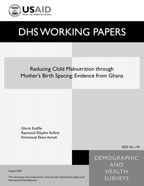There is no printed copy available to order.
Abstract:
Although research has focused on the impact
of birth spacing on maternal health,
inadequate maternal repletion due to shorter
birth intervals could also affect the health
of the child. However, limited studies exist
on the linkage between birth spacing and
child nutrition. This study examines the
association between birth spacing and child
stunting and underweight using the 2014 Ghana
Demographic and Health Survey. The study
employed descriptive statistics and logistic
regressions to establish the association
between birth spacing and child stunting and
underweight. The analyses reveal that
childbirth spacing between 24 to 35 months
(OR = 0.6, 95% CI [0.4, 1.0]; p < .1), 36 to
47 months (OR = 0.4, 95% CI [0.3, 0.7]; p <
.01), and beyond 47 months (OR = 0.5, 95% CI
[0.3, 0.9]; p < .05) have lower odds of child
stunting than children with birth spacing
less than 24 months. Children with birth
spacing between 24 to 35 months (OR = 0.5,
95% CI [0.3, 1.0]; p < .05), 36 to 47 months
(OR = 0.4, 95% CI [0.2, 0.9]; p < .05) and
beyond 47 months (OR =0.5, 95% CI [0.3, 0.9];
p < .05) have lower odds of being underweight
than those with birth spacing less than 24
months. The findings reveal a negative
association between shorter birth spacing and
child stunting and underweight, which
suggests that shorter birth spacing is
associated with higher odds of child
malnutrition. The study recommends that Ghana
Health Service and other healthcare providers
should educate mothers on the gains of birth
spacing of at least 2 years for their
children.
 Reducing Child Malnutrition through Mother's Birth Spacing: Evidence from Ghana (PDF, 1289K)
Reducing Child Malnutrition through Mother's Birth Spacing: Evidence from Ghana (PDF, 1289K)
